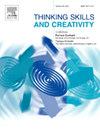知识整合指导下学生高阶能力上升螺旋模式的形成性评价
IF 4.5
2区 教育学
Q1 Social Sciences
引用次数: 0
摘要
本研究旨在追踪知识整合课程下学生学习过程中高阶能力的动态变化。课程包括概念框架和形成性评估,作为跨光合作用、呼吸作用和食物链的课堂讨论工具,以促进学生从表面学习到深入学习和转移阶段的学习过程。特别是对四项高阶能力(即循证推理、模型构建、系统观点和批判性讨论)的形成性评估,在得分和一致性方面进行。参与者是132名12至14岁的七年级学生。该课程有效提高了学生的四项高阶能力,包括分数和自我一致性以及与知识掌握、批判性思维和解决问题的总结性评价的一致性。四种高阶能力在光合作用、呼吸作用和食物链的教学中呈现出不同动态的上升螺旋模式。课程有效地培养了学生从表层学习到深层学习和迁移阶段的学习过程,从而促进了高阶能力的习得和巩固。四种高阶能力具有一定的层次结构,表现出对学习过程依赖的不同模式。本文章由计算机程序翻译,如有差异,请以英文原文为准。
Formative assessment on the upward spiral patterns of students’ high-order abilities under knowledge integration instruction
This study aimed to track the dynamic changes of high-order abilities during the learning process under a knowledge integration-based curriculum. The curriculum included the conceptual framework and a formative assessment as a classroom discussion tool across photosynthesis, respiration and food chains to foster students’ learning process from surface learning to deeper learning and transfer stages. In particular, the formative assessment on four high-order abilities (i.e., evidence-based reasoning, model construction, systematic view and critical discussion) was done in score and consistency. Participants were 132 seventh-grade students aged 12 to 14 years. The curriculum effectively improved students’ four high-order abilities in score and self-consistency and consistency with summative assessment of knowledge mastery, critical thinking and problem solving. The four high-order abilities showed the upward spiral patterns with different dynamics with the teaching across photosynthesis, respiration and food chains. The curriculum effectively fostered students’ learning process from surface learning to deeper learning and transfer stages, thereby prompting the acquiring and consolidating of high-order abilities. The four high-order abilities had a hierarchical order, showing the patterns differentiating in the dependence of the learning process.
求助全文
通过发布文献求助,成功后即可免费获取论文全文。
去求助
来源期刊

Thinking Skills and Creativity
EDUCATION & EDUCATIONAL RESEARCH-
CiteScore
6.40
自引率
16.20%
发文量
172
审稿时长
76 days
期刊介绍:
Thinking Skills and Creativity is a new journal providing a peer-reviewed forum for communication and debate for the community of researchers interested in teaching for thinking and creativity. Papers may represent a variety of theoretical perspectives and methodological approaches and may relate to any age level in a diversity of settings: formal and informal, education and work-based.
 求助内容:
求助内容: 应助结果提醒方式:
应助结果提醒方式:


